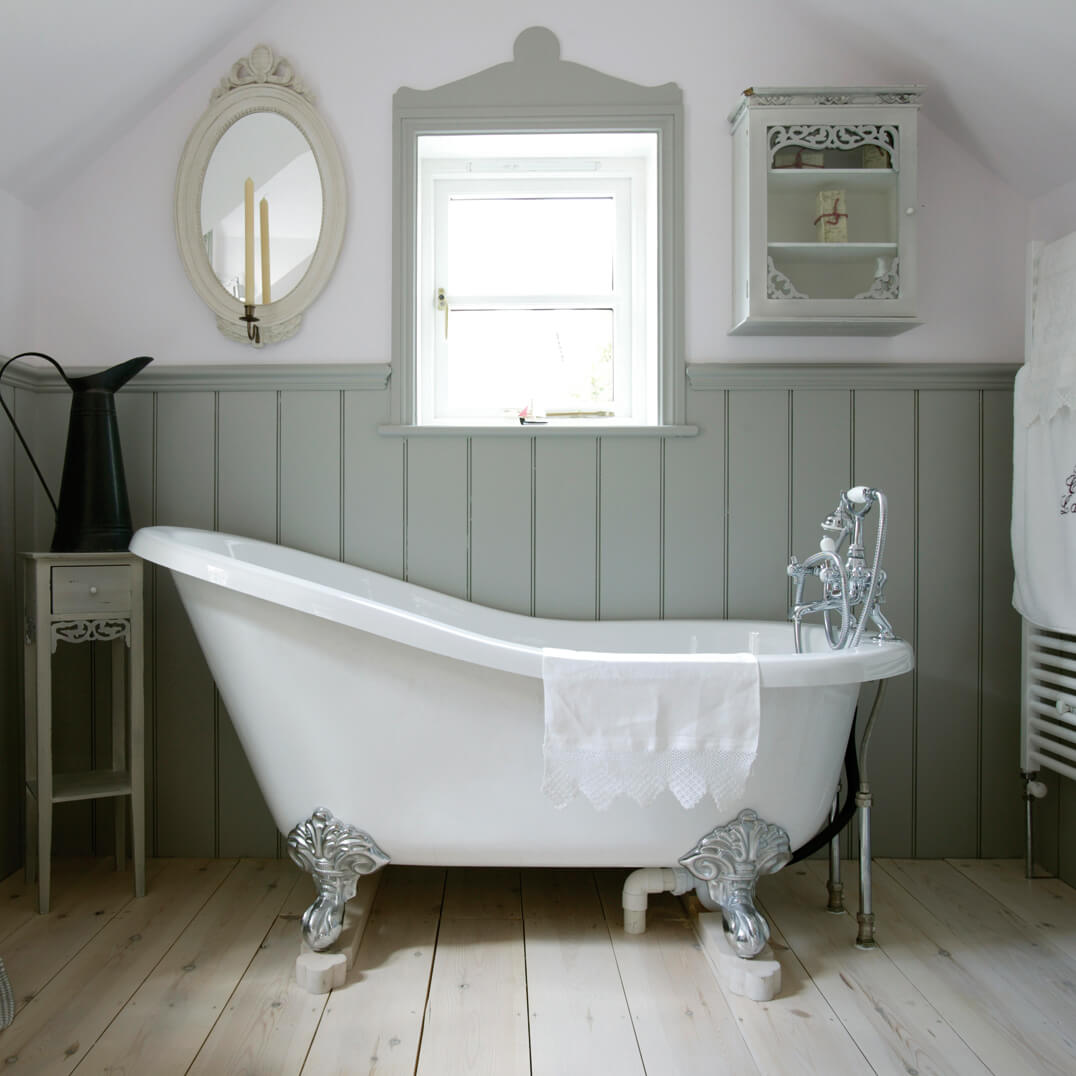Design Considerations for Wood Paneling in Bathrooms

Wood paneling can add warmth, character, and a touch of rustic charm to a bathroom. However, choosing the right style, color, and finish is crucial to create a cohesive and aesthetically pleasing design.
Styles of Wood Paneling for Bathrooms, Painting bathroom wood panelling
The style of wood paneling you choose should complement the overall bathroom design. Here are some popular styles:
- Traditional: Traditional wood paneling often features classic designs like beadboard or wainscoting. These styles are characterized by their simple, timeless appeal and can add a touch of elegance to a bathroom.
- Modern: Modern wood paneling typically features clean lines, geometric patterns, and sleek finishes. This style can create a minimalist and contemporary look in a bathroom.
- Rustic: Rustic wood paneling often uses reclaimed wood or distressed finishes to create a cozy and natural feel. This style is perfect for bathrooms with a farmhouse or cabin aesthetic.
- Contemporary: Contemporary wood paneling embraces modern trends with bold colors, unique textures, and innovative designs. This style can create a statement piece in a bathroom.
Color and Finish Considerations
The color and finish of the wood paneling can significantly impact the overall ambiance of the bathroom.
- Light Colors: Light-colored wood paneling can make a bathroom feel larger and brighter. This is especially beneficial for smaller bathrooms. White, cream, and light gray are popular choices for a clean and airy look.
- Dark Colors: Dark-colored wood paneling can add a sense of sophistication and drama to a bathroom. However, it can also make the space feel smaller. Consider using dark colors on accent walls or in smaller areas to avoid overwhelming the space.
- Finishes: The finish of the wood paneling can affect its appearance and durability. Common finishes include:
- Natural: Natural finishes showcase the wood’s natural grain and color.
- Stained: Stains enhance the wood’s natural color and grain, adding depth and dimension.
- Painted: Painting wood paneling allows for greater customization and can create a clean and modern look.
Design Concept for a Bathroom with Wood Paneling
Here’s a design concept for a bathroom featuring wood paneling:
- Style: Contemporary with a touch of rustic charm.
- Wood Paneling: Light-colored reclaimed wood with a natural finish. The wood can be used to create a feature wall behind the vanity or as wainscoting around the perimeter of the room.
- Lighting: A combination of natural light from a large window and warm, ambient lighting from pendant lights above the vanity and recessed lights in the ceiling.
- Fixtures: Sleek and modern fixtures in brushed nickel or black finishes, such as a freestanding bathtub, a wall-mounted toilet, and a minimalist vanity with a floating countertop.
- Accessories: Natural elements like plants, woven baskets, and wooden shelves add a touch of warmth and texture to the space.
Practical Considerations for Wood Paneling in Bathrooms: Painting Bathroom Wood Panelling

Installing wood paneling in a bathroom requires careful planning and execution to ensure its longevity and aesthetic appeal. This section delves into the practical aspects of this project, addressing crucial considerations for moisture resistance, ventilation, and proper maintenance.
Installation Process
Installing wood paneling in a bathroom involves a series of steps, each requiring attention to detail to ensure a successful outcome.
- Preparation: Begin by preparing the bathroom walls. Remove existing finishes, such as wallpaper or paint, and ensure the surface is clean, dry, and smooth. Any cracks or imperfections should be repaired with spackle or patching compound.
- Moisture Barrier: Installing a moisture barrier is crucial to protect the wood paneling from moisture damage. A vapor barrier, typically made of polyethylene sheeting, should be applied to the walls before installing the paneling. This barrier prevents moisture from penetrating the wood and causing warping or mold growth.
- Framing: Install a framework of studs or furring strips to create a solid base for the paneling. This framing should be spaced according to the width of the paneling boards and should be attached to the wall using moisture-resistant screws or nails.
- Paneling Installation: Begin attaching the paneling boards to the framing, starting from a corner and working your way across the wall. Use moisture-resistant adhesive and fasteners to secure the boards. Ensure that the boards are properly aligned and butted together tightly.
- Finishing Touches: After installing the paneling, apply a sealant to the joints and edges to prevent moisture from seeping into the wood. This sealant should be specifically designed for use in bathrooms and should be applied according to the manufacturer’s instructions.
- Ventilation: Adequate ventilation is essential to prevent moisture buildup in the bathroom. Ensure that the bathroom has a working exhaust fan that can remove moisture from the air. Consider adding a window for natural ventilation as well.
Maintenance and Care
Maintaining wood paneling in a bathroom is crucial to preserve its beauty and extend its lifespan.
- Regular Cleaning: Regularly clean the paneling with a mild detergent and water solution. Avoid using harsh chemicals or abrasive cleaners that can damage the finish.
- Moisture Control: Ensure that the bathroom is well-ventilated to prevent moisture buildup. Use an exhaust fan during and after showers to remove excess steam.
- Sealing: Regularly inspect the sealant around the paneling for cracks or gaps. Reseal any damaged areas promptly to prevent moisture from penetrating the wood.
- Warpage and Mold: Monitor the paneling for signs of warping or mold growth. If any issues arise, address them promptly by contacting a qualified professional.
Essential Tools and Materials
Installing wood paneling in a bathroom requires specific tools and materials.
- Tools:
- Measuring tape
- Level
- Circular saw or jigsaw
- Drill with appropriate drill bits
- Hammer
- Safety glasses
- Work gloves
- Materials:
- Wood paneling boards
- Moisture-resistant framing lumber
- Moisture-resistant screws or nails
- Vapor barrier (polyethylene sheeting)
- Moisture-resistant adhesive
- Sealant for bathroom use
- Caulk
- Primer and paint (optional)